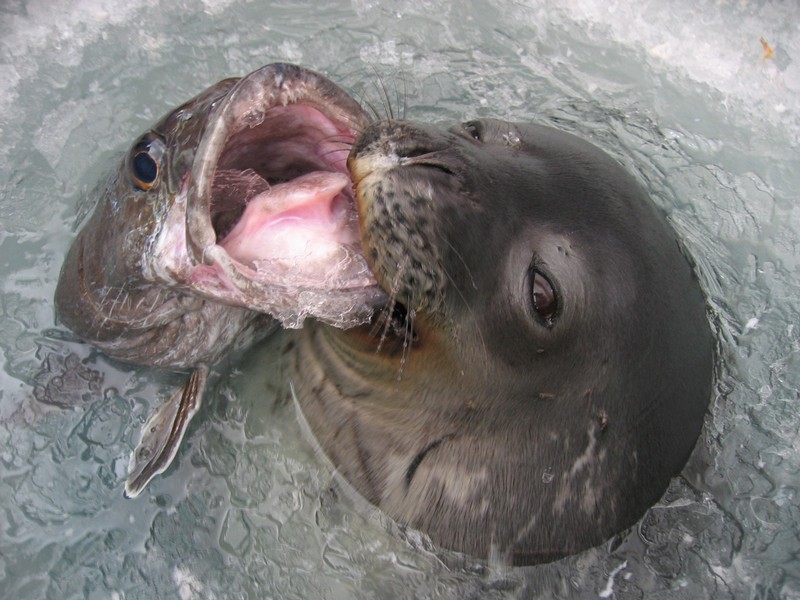Difference between revisions of "Template:POTD protected"
Westarctica (talk | contribs) |
Westarctica (talk | contribs) |
||
| Line 1: | Line 1: | ||
{| role="presentation" style="margin:0 3px 3px; width:100%; text-align:left; background-color:transparent; border-collapse: collapse; " | {| role="presentation" style="margin:0 3px 3px; width:100%; text-align:left; background-color:transparent; border-collapse: collapse; " | ||
|style="padding:0 0.9em 0 0;" | [[File: | |style="padding:0 0.9em 0 0;" | [[File:Seal-&-toothfish-Jessica-Meir N.jpg|300px]] | ||
|style="padding:0 6px 0 0"| | |style="padding:0 6px 0 0"| | ||
'''[[ | The '''[[Weddell seal]]''' is a relatively large and abundant true seal with a circumpolar distribution surrounding [[Antarctica]]. Weddell seals have the most southerly distribution of any mammal, with a habitat that extends as far south as McMurdo Sound (at 77°S). Because of its abundance, relative accessibility, and ease of approach by humans, it is the best-studied of the Antarctic seals. An estimated 800,000 individuals remain today. Weddell seal pups leave their mothers at a few months of age. In those months, they are fed by their mothers' warming and fat-rich milk. They leave when they are ready to hunt and are fat enough to survive in the harsh weather. Weddell seals commonly consume [[Antarctic toothfish]], [[Antarctic krill]], and [[Glacial squid]]. A sedentary adult eats around 10 kg (22 lb) a day, while an active adult eats over 50 kg (110 lb) a day. The Weddell seal was discovered and named in the 1820s during expeditions led by James Weddell, the British sealing captain, to the parts of the [[Southern Ocean]] now known as the [[Weddell Sea]]. | ||
<p><small>Photographer: | <p><small>Photographer: Jessica Meir</small></p> | ||
[[:Category:Images|'''(More Featured Images)''']] | [[:Category:Images|'''(More Featured Images)''']] | ||
<div class="potd-recent" style="text-align:right;"> | <div class="potd-recent" style="text-align:right;"> | ||
Revision as of 16:50, 11 May 2018

|
The Weddell seal is a relatively large and abundant true seal with a circumpolar distribution surrounding Antarctica. Weddell seals have the most southerly distribution of any mammal, with a habitat that extends as far south as McMurdo Sound (at 77°S). Because of its abundance, relative accessibility, and ease of approach by humans, it is the best-studied of the Antarctic seals. An estimated 800,000 individuals remain today. Weddell seal pups leave their mothers at a few months of age. In those months, they are fed by their mothers' warming and fat-rich milk. They leave when they are ready to hunt and are fat enough to survive in the harsh weather. Weddell seals commonly consume Antarctic toothfish, Antarctic krill, and Glacial squid. A sedentary adult eats around 10 kg (22 lb) a day, while an active adult eats over 50 kg (110 lb) a day. The Weddell seal was discovered and named in the 1820s during expeditions led by James Weddell, the British sealing captain, to the parts of the Southern Ocean now known as the Weddell Sea. Photographer: Jessica Meir |